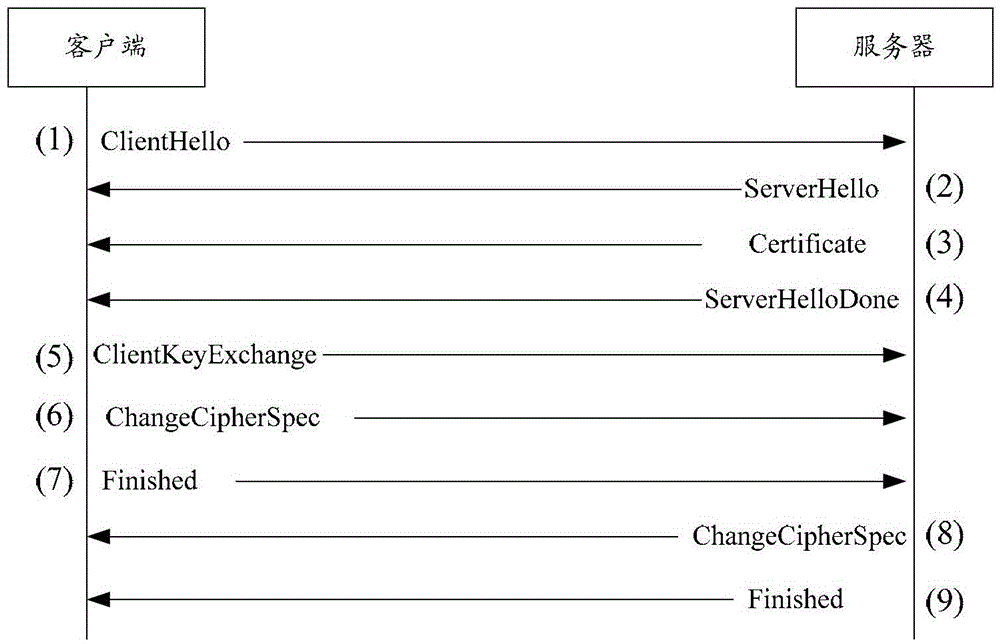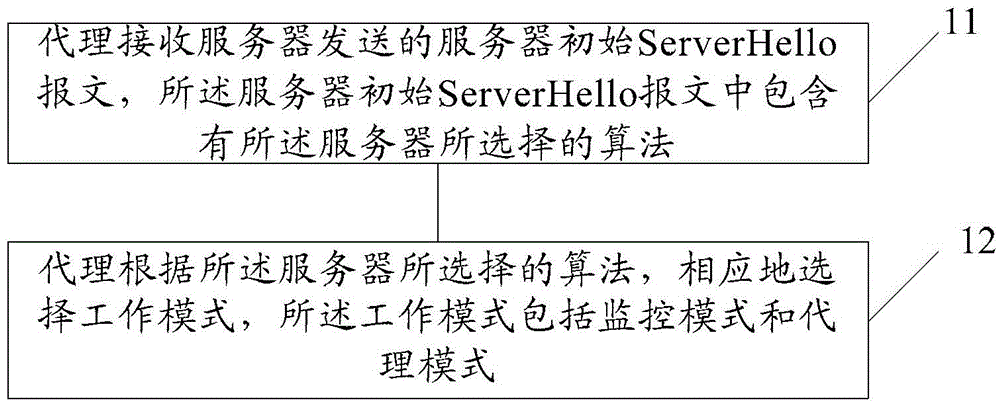A method and device for tls scanning
A network device, RSA algorithm technology, applied in the field of TLS scanning, can solve problems such as inefficiency, does not support client authentication, does not support certain algorithms, etc., and achieves improved processing performance, efficient algorithms and/or client authentication. Effect
- Summary
- Abstract
- Description
- Claims
- Application Information
AI Technical Summary
Problems solved by technology
Method used
Image
Examples
Embodiment 1
[0048] Figure 4 It is a schematic diagram of the interaction between the client, agent, and server when supporting the export RSA algorithm without ServerKeyExchange or the standard RSA algorithm without ServerKeyExchange. Reference Figure 4 The TLS scanning method provided in this embodiment may include:
[0049] Deploy the server certificate on the proxy.
[0050] When the agent receives the ServerHello message, it checks the cipher_suite (algorithm suite) field in ServerHello to determine whether the key exchange algorithm is RSA or export RSA (RSA_Export) algorithm.
[0051] If the agent determines that the key exchange algorithm is the RSA algorithm or the export RSA algorithm and does not receive the ServerKeyExchange message, the agent works in the monitoring mode and does not modify any messages. At this time, the specific process of interaction between the client, agent and server is as follows Figure 4 Shown.
[0052] When the agent receives the ClientKeyExchange message...
Embodiment 2
[0056] Figure 5 with Image 6 It is a schematic diagram of the interaction between the client, the proxy and the server when the DH algorithm is supported. The TLS scanning method provided in this embodiment may include:
[0057] Deploy the server certificate on the proxy.
[0058] When the agent receives the ServerHello, it confirms whether it is the RSA algorithm or the export RSA algorithm.
[0059] If it is the RSA algorithm or the export RSA algorithm, and the ServerKeyExchange message is not received, the agent works in the monitoring mode and does not modify any messages. The agent obtains the pre-master key by decrypting the ClientKeyExchange message, and derives the session key according to the TLS standard to decrypt subsequent TLS record messages. The process ends.
[0060] If it is a DH algorithm, the agent works in a proxy mode and regenerates a new ServerHello or ServerKeyExchange message. The agent can make this selection according to local policies.
[0061] Specifi...
Embodiment 3
[0096] Figure 7 It is a schematic diagram of the interaction between the client, the agent and the server when the export RSA algorithm with ServerKeyExchange or the non-standard RSA algorithm with ServerKeyExchange is supported. Reference Figure 7 The TLS scanning method provided in this embodiment may include:
[0097] Deploy the server certificate on the proxy.
[0098] When the agent receives the ServerHello, it confirms whether it is the RSA algorithm or the export RSA algorithm.
[0099] If it is the RSA algorithm or the export RSA algorithm, and the ServerKeyExchange message is not received, the agent works in the monitoring mode and does not modify any messages. The agent obtains the pre-master key by decrypting the ClientKeyExchange message, and derives the session key according to the TLS standard to decrypt subsequent TLS record messages. The process ends.
[0100] If the agent receives the export RSA algorithm or the RSA algorithm in ServerHello, and receives the Serve...
PUM
 Login to View More
Login to View More Abstract
Description
Claims
Application Information
 Login to View More
Login to View More - R&D
- Intellectual Property
- Life Sciences
- Materials
- Tech Scout
- Unparalleled Data Quality
- Higher Quality Content
- 60% Fewer Hallucinations
Browse by: Latest US Patents, China's latest patents, Technical Efficacy Thesaurus, Application Domain, Technology Topic, Popular Technical Reports.
© 2025 PatSnap. All rights reserved.Legal|Privacy policy|Modern Slavery Act Transparency Statement|Sitemap|About US| Contact US: help@patsnap.com



